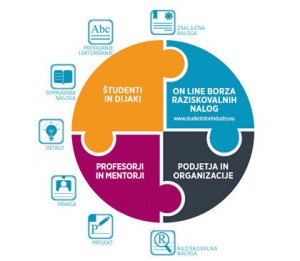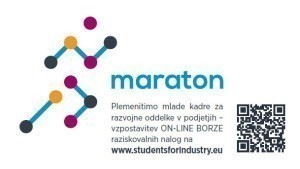
Project Title: We honor young employees for development departments in companies - establish a support service for companies in the form of an on-line exchange of research student work in companies
Status of project: completed
Project type: international
Duration: December 2013 - June 2015
Financing: The project is implemented under the Operational Program of Cross-border Cooperation Slovenia-Croatia 2007-2013 and is co-financed by the EU under the. The Instrument for Pre-Accession Assistance (IPA) and the Government Office for Local Self-Government and Regional Policy (SVLR).
Head of the project at SRC Bistra Ptuj: dr. Lidija Tušek
Partners:
- Scientific Research Centre Bistra Ptuj, SLO, www.bistra.si (Lead Partner),
- Technological Innovation Center Međimurje d.o.o., HR, www.ticm.hr
- Zagorska razvojna agencija d.o.o. (ZARA), HR, www.zara.hr,
- TECES, Technology Center for Electrical Machines, SLO, www.teces.si,
- Agency for Development of Varaždin County (AZRA), HR, www.azra.hr,
- Development center Murska Sobota, SLO, www.rcms.si,
- TehnoCenter of the University of Maribor d.o.o., SLO, www.tehnocenter.si,
- University of Zagreb, HR, www.unizg.hr.

Objectives/ Goals:
The MARATON project aims to promote the integration of enterprises, especially SMEs, with R & D institutions in order to stimulate the development of new products, services and technologies with greater added value, thus increasing the competitiveness of SMEs. We will develop a product in the project, which will be promoted across borders by target groups and the public. This product will be an on-line exchange of research tasks in which companies will enroll the research tasks to which students will apply for the pursuit of practices, diploma or master's theses in connection with researchers-mentors from R & D institutions. The stock exchange will be free and open to everyone. The availability of information on concrete development challenges in a particular company that will publish a research task on the stock exchange will encourage cooperation beyond the borders. In addition to the targeted links, the company-student-researcher will also be able to conclude the company-company links, which can further contribute to the bilateral business linkage due to the same or similar development challenges. Similarly, links to researchers. Established connections can trigger the domino effect of further linking the project area. The added value of the project is the contribution to a more successful search and recruitment of development staff and the cross-border exchange of business ideas and personnel.

Needs covered by the project:
The border region of Slovenia-Croatia is an economically less developed area on both sides of the border. In the post-2008 period, the economic situation deteriorated due to the economic crisis. A number of large companies based on labor-intensive industries have encountered problems and, especially in the construction sector, there is a sharp decline in economic activity, and the same problems appear on both sides of the border and suggest solutions that can benefit everyone. For the economy of the border regions, small and medium-sized enterprises (SMEs) are gaining in importance, which generally have better indicators of economy and profitability than large companies. The first condition for increasing the competitive advantage of companies leading to economic growth is the development of new products, technologies and services, which is linked to R & D efforts. It is necessary to promote innovation in companies at all levels and to invest more knowledge and more cooperation between enterprises, in particular SMEs, and R & D institutions in innovation.
A survey from the SPRINT project showed that on both sides of the border there are the same problems with innovation and consequently increasing the competitiveness of companies, so the same or similar solutions are reasonable. Companies, like most researchers from the academic sphere, want to work together, but common research projects are rare. Researchers from R & D institutions are not motivated enough and are too busy to cooperate with the economy, and companies often do not know the competences of individual researchers because they are not interested in scientific achievements, and therefore, the quality of contacts between companies and researchers from R & D institutions rarely occurs. In addition to poor mutual knowledge and understanding, businesses, as one of the major obstacles to innovation, cited the issue of the relevant development staff that they find difficult to access. They need their own staff who are capable of insightful insight into the company's needs, which relate to the development of new technologies, products and services, taking into account business logic and company policies. Such staff requires a link between R & D institutions and companies, which is why we selected the students as a target group. In virtually all companies where we identified innovation potential in the SPRINT project, regardless of their size, it is a common finding that it is very difficult for quality staff to come because they are not familiar with the right students. At the same time, due to the rigid recruitment legislation, companies are afraid to employ highly educated technical staff, because their work is not only expensive, but also their training. It is therefore important that companies have the opportunity to select good students and to test them on concrete tasks.
There is, however, a third aspect of the whole issue. Modern higher education systems are based on promoting contacts between businesses and students. Students are obliged, within the framework of their course of study, to pursue study practice and diploma studies or master's or even doctoral thesis on problems from the economy. Good students do not have enough information and sufficient access to research challenges in companies, and therefore the best ones often look for challenges abroad or at least in larger cities outside the border area. Better information and the establishment of a communication channel between students and businesses could keep the best staff in the region. Personnel is one of the most important factors for the success of companies and thus the way to greater competitiveness of enterprises.
The MARATON project is based on the assumption that we can stimulate the participation of the economy and R & D institutions through the creation of a junction in the form of a simple exchange of development and research topics and tasks that are of interest to companies. Students will be included in these tasks with a motive to carry out their study obligations, contact and work with a quality job with a potential employer. The motive of professors-mentors is twofold: pedagogical and establishing cooperation with the economy. The motives of companies are: test of potential employees for development tasks in concrete work, introduction of potential employees in organizational and business processes of the company even before employment, which shortens the adjustment times when possible employment.
Description / Results:
- Established cross-border support service for companies in the form of on-line student exchange research for better cooperation between enterprises and R & D institutions.
- Identified development challenges in enterprises in a cross-border area, suitable for student research work.
- New partnerships between businesses, students and researchers have been established.
- Improved availability of businesses for students and researchers.
- Several graduation theses that solve the real challenges in companies.
Benefits of project results for the local environment:
The project encourages the participation of companies, university students and researchers in joint research projects. All these activities increase the competitive advantage of local businesses and facilitate business access to the most promising development staff on the one hand, and the access of highly educated staff to companies.
Information brochure of the Maraton project
The path to the online stock exchange of student research tasks in the cross-border SI-HR area



